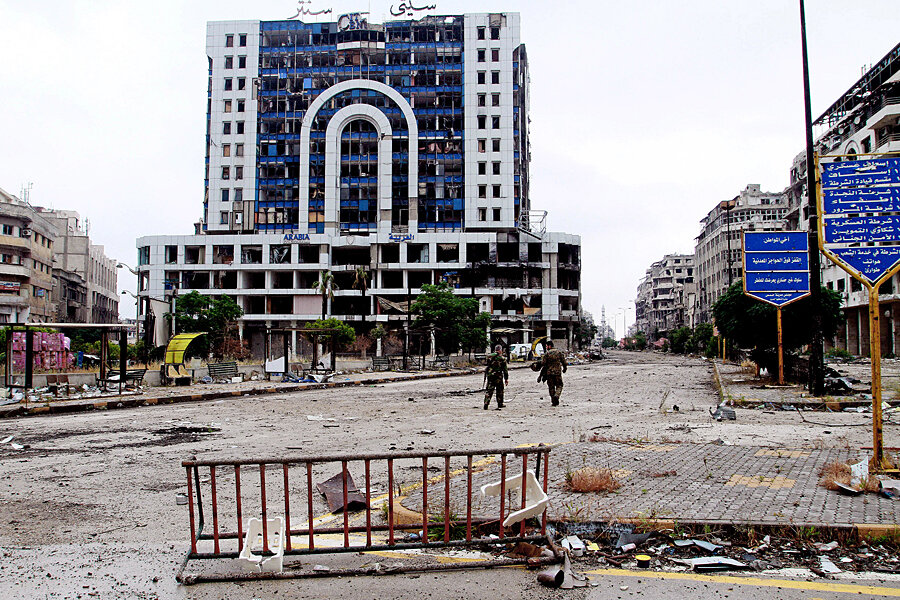Rebel evacuation of Homs is crowning moment for Syrian regime
Loading...
| Beirut, Lebanon
Hundreds of weary Syrian rebels have been evacuated from opposition-held quarters of Homs in the past two days as part of a cease-fire arrangement, ending a bitter struggle for the once-acclaimed capital of the revolution.
The retreat of the estimated 1,200 rebels from Syria's third-largest city is perhaps the crowning moment of the Assad regime’s year-long campaign to claw back opposition-held territory. With Homs firmly under its control for the first time in more than two years, the Assad regime has further consolidated its grip on the crucial corridor linking Damascus to Syria's Mediterranean ports. It also ensures access to the coastal mountain chain that is home to the Alawite sect to which President Bashar al-Assad belongs.
The victory affords Syria's leader renewed confidence ahead of a presidential election on June 3 in which he seeks another seven-year term to shore up his legitimacy.
The cease-fire deal was brokered by the United Nations and took months to negotiate. It also allows for an aid convoy to besieged Shiite villages north of Aleppo and the release of prisoners held by rebels. Some of those prisoners are reportedly Iranians and fighters from the Lebanese Shiite militant group Hezbollah.
Homs was the first major city in Syria where the revolt to unseat Assad took root in 2011. Its fall caps a year of regime battlefield successes: regaining the Qalamoun region between Damascus and Homs, driving rebel forces further from central Damascus, and crushing opposition pockets between Homs and Tartous on the coast.
While falling far short of outright victory, the military campaign has staved off the threat of imminent defeat and restored regime control over much of western Syria. The recent successes will likely reinforce the emerging de-facto partition of Syria, with the regime holding the western half and the rebels controlling the north and east.
How they did it
According to European diplomats and intelligence sources, Iranian advisors have played a critical role in reversing the tide against the Assad regime. Initial army offensives against rebel areas exacted high military casualties, which gutted the top brigades and exhausted the troops.
Under Iranian guidance, the Syrian regime has adopted “surrender or starve” siege tactics, surrounding and sealing off rebel neighborhoods and pounding them into submission with air strikes, barrel bombs and artillery. Hezbollah’s battle-hardened fighters are the “pivotal” spearhead of the regime’s offensive, backed by some 80,000 fighters with the Iran-trained National Defense Force, a mainly Alawite militia, and 20,000 to 30,000 Iraqi Shiite volunteers, says a Beirut-based European diplomat.
“The Iranians are running the show. They are contracting Iraqi Shiites to serve six-month tours in Syria with a guaranteed job when they go home. They are picking up all the unemployed Shiites,” the diplomat says.
Iran and Russia also have provided significant logistical and financial support for the Assad regime.
Rebels undefeated
On the other side, the political opposition remains disorganized and lacking in credibility while the armed rebels are hopelessly divided and dominated by extremists, who have scared off potential Western backers.
“The quality of support for Bashar is so much higher than the quality of support for the opposition. And that is what has saved Bashar,” the diplomat says.
Still, while the Assad regime has proved effective at regaining rebel-held ground, holding the terrain may prove a different matter given its stretched military manpower. Already, rebels have mounted a counter-attack in eastern Qalamoun. This week they overran a large arms depot and cut the highway linking Damascus to Deir ez Zor in the east.
The rebel move threatens to isolate the military's Sayqal air force base 50 miles east of Damascus, which is believed to be holding the last stockpile of chemical weapons awaiting transfer out of Syria.







